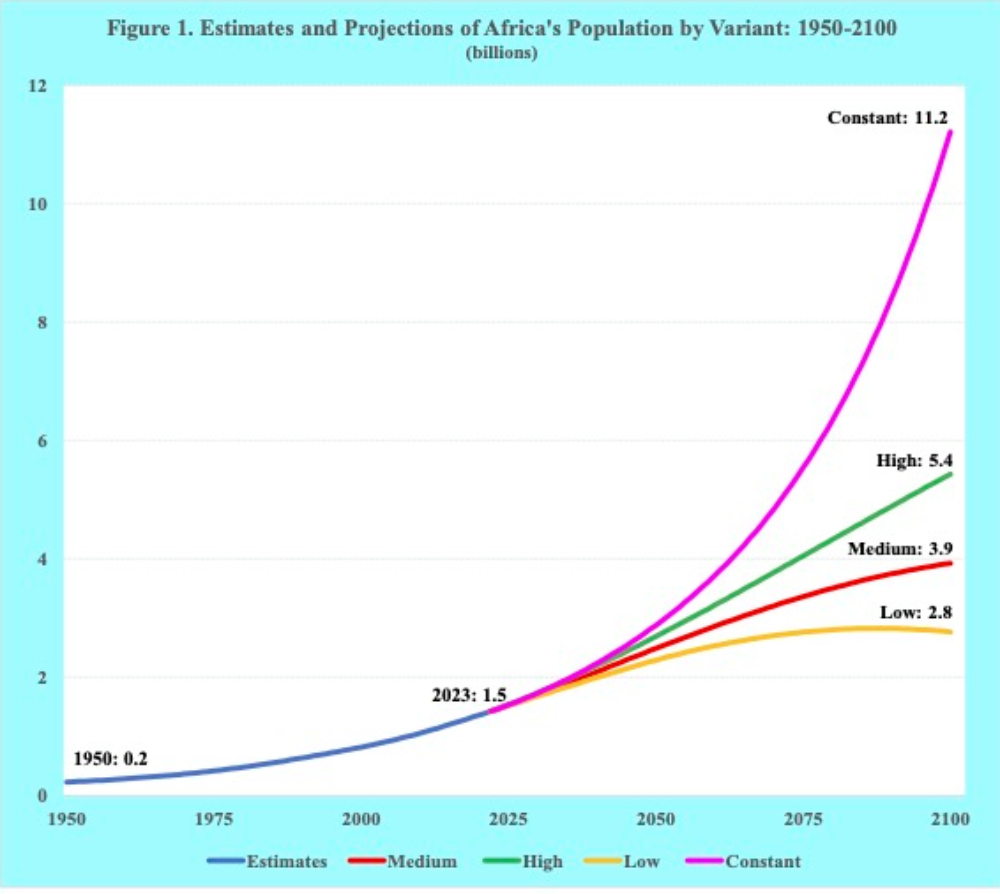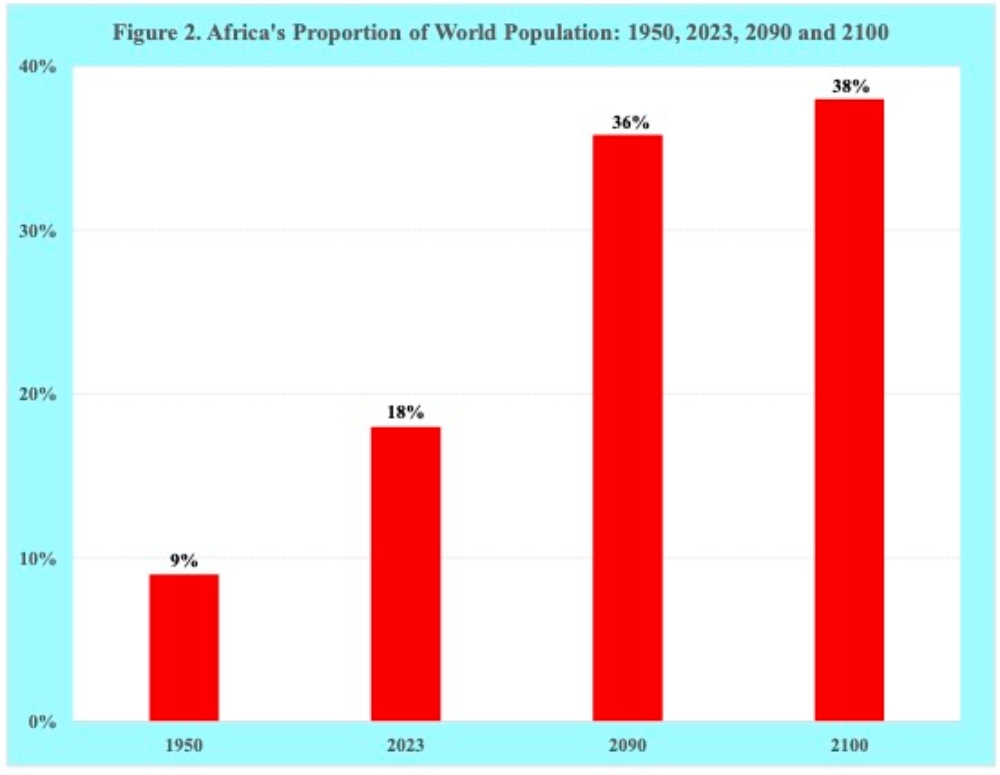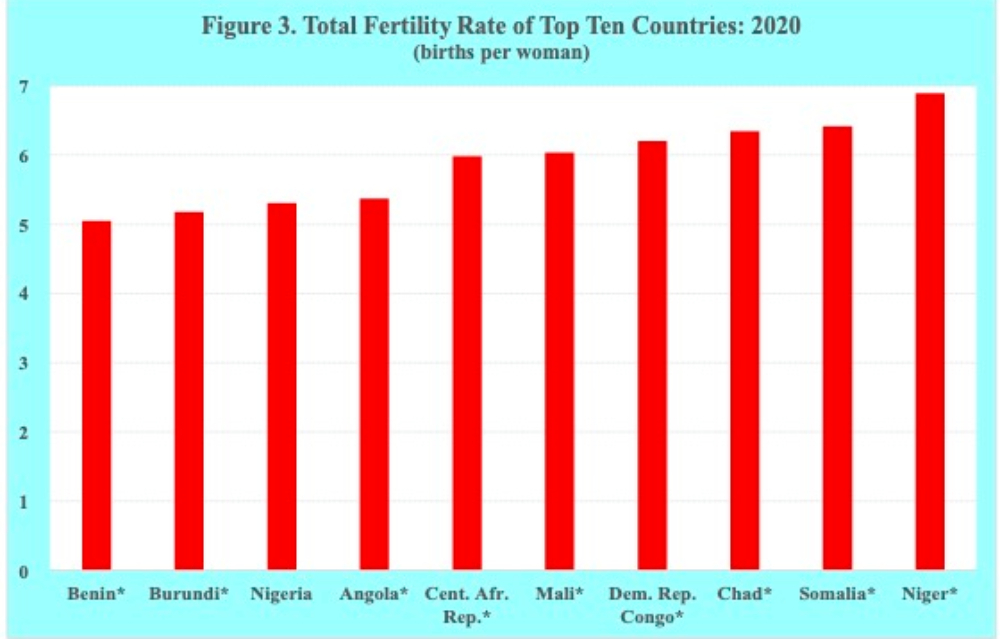The population of Africa experienced a rapid demographic ascent over the recent past. Whereas Africa’s population in 1950 was approximately 250 million, today it has increased six-fold to approximately 1.5 billion
Africa’s population ascent is expected to continue throughout the 21st century. According to the United Nations medium variant projection, Africa’s current population of 1.5 billion is expected to more than double by the year 2100, reaching 3.9 billion, which amounts to nearly a quintupling of that continent’s population during the 21st century (Figure 1).
Source: United Nations.
Additional United Nations projection variants offer a broad range of possible demographic growth paths for Africa’s future population. Those growth paths depend largely on the course of fertility levels over the coming decades.
If fertility levels fall more rapidly than are now expected, the United Nations' low population projection variant foresees Africa’s population reaching 2.8 billion by the century’s close. However, if fertility levels decline more slowly than now envisaged, the United Nations' high population projection variant expects the current population of Africa to more than triple to 5.4 billion by 2100.
Another instructive United Nations projection variant provides additional insight into Africa’s possible future population. That projection variant assumes that the current fertility levels of Africa’s countries remain constant for the remainder of the century.
According to the constant projection variant, Africa’s current population of 1.5 billion will double to 3 billion by 2050, double again to 6 billion by the year 2078 and nearly doubles a third time to 11. 2 billion by the close of the 21st century.
In other words, if the fertility rates of Africa’s 54 countries were to remain unchanged at their current levels for the next 75 years, Africa’s population of 1.5 billion today would experience nearly an eight-fold increase by 2100, reaching more than 11 billion inhabitants.
As a result of Africa’s relatively rapid demographic ascent over the past 70 years, its proportion of the world’s population has increased substantially. In 1950 Africa’s population was 9 percent of the world’s population of 2. 5 billion. By 2023, that proportion has doubled to 18 percent of the world’s population of 8 billion (Figure 2).
Source: United Nations.
According to the UN medium variant projection, Africa’s proportion of the world’s population is expected to double again during the 21st century. By 2090, Africa is expected to account for 36 percent of the world’s population and for nearly 40 percent by the century’s close when the world population is projected to reach 10.4 billion.
As is apparent from the above population projection variants, the size of Africa’s population in the coming decades is expected to be substantially larger than it is today. Of course, demographic conditions, especially mortality levels, could change markedly, perhaps even worsen over the coming decades.
Nevertheless, current United Nations population projections assume Africa’s mortality levels will continue to improve over the coming decades. The continent’s life expectancy at birth rose from about 38 years in 1950 to 62 years in 2020. That positive trend in mortality rates is expected to continue for the rest of the century, with Africa’s life expectancy at birth projected to reach 70 years by around 2060 and 75 years by the century’s close.
While Africa’s fertility levels have declined substantially over the past century, they remain relatively high in comparison to the rest of the world. Africa’s fertility rate of about 6.6 births per woman in 1950 has declined to about 4.4 births per woman in 2020.
Nevertheless, fertility levels have remained comparatively high in many sub-Saharan nations. Fertility rates in excess of 5 births per woman are observed in no less than 10 sub-Saharan countries. And in some cases, such as the Democratic Republic of the Congo, Chad, Niger, and Somali, the total fertility rates are in excess of 6 births per woman (Figure 3).
Source: United Nations. Least developed country.
As a result of those relatively high fertility rates, the population of approximately 10 African countries are expected to more than double by 2060. Those projected population increases by 2060 include 109 percent in Sudan, 113 percent in Uganda, 136 percent in Tanzania, 142 percent in Angola, 147 percent in Somalia, 167 percent in the Democratic Republic of the Congo and 227 percent in Niger.
The African country with the largest population, Nigeria, is also projected to experience rapid population growth. Having more than doubled over the past 30 years, from 100 million in 1992 to 219 million in 2022, Nigeria is expected to continue its rapid demographic growth over the remainder of the century.
The population of Nigeria is expected to become larger than the U.S. population by 2050 when it reaches 377 million, which will make Nigeria the third largest population in the world. Nigeria’s rapid population growth is projected to continue, reaching 500 million by 2077 and 546 million by the century’s close.
Another populous African country experiencing rapid demographic growth is the Democratic Republic of the Congo (DRC). From less than 13 million in 1950, the population of the DRC increased more than sevenfold to about 93 million by 2020. Due to its high fertility rates, the population of the DRC is projected to nearly triple by 2060, reaching 267 million and making it the sixth largest population in the world at that time.
Largely as a result of their high fertility rates, the median ages of the African countries are among the world’s youngest. In many African countries, including Angola, the DRC, Nigeria, Niger and Somalia, approximately half of the population are children. Some of those countries have even younger population age structures, such as the Central African Republic, Chad and Niger, with a median age of 15 years in 2020.
Turning to migration, large numbers of Africans are seeking to emigrate due to limited opportunities, difficult living conditions, political upheaval and conflict. Half or more of the populations of various African countries, including the DRC, Sierra Leone and Liberia, say they would like to emigrate to another country, typically to Europe and North America.
In Africa’s most populous country, Nigeria, about half of its population of approximately 225 million people want to leave the country and resettle abroad, preferably in an English-speaking country. With an estimated 40 per cent of the population living in poverty, many Nigerians have already left the country through migration programs as well as illegal migration and many others have applied for asylum and refugee protection.
In addition to dealing with growing populations and high levels of poverty, African countries, many of which are classified as least developed nations, are facing considerable difficulties in reducing hunger, providing essential services, offering education, decent work and employment opportunities, promoting women’s rights, providing healthcare, reducing inequalities and resolving internal conflict.
In some of Africa’s high-fertility countries, the proportions of the populations suffering from undernourishment are substantial. For example, the proportion of undernourished is estimated at 60 per cent in Somalia, 48 per cent in the Central African Republic and 42 per cent in the DRC. Also, many African countries, such as Ethiopia, Kenya, Somalia, South Sudan and Sudan, are in urgent need of humanitarian aid and protection.
Moreover, dire concerns are increasingly emerging regarding housing, energy supplies, natural resources, biodiversity, pollution, the environment, and, of course, climate change. Various studies report that Africa is likely to be the most vulnerable continent to climate change impacts.
The effects of climate change are expected to be particularly pronounced in sub-Saharan countries due to temperature increases, changes in rainfall patterns, extreme weather patterns and increasing natural disasters. For many rapidly growing African populations, those effects already pose serious risks to water and food systems, public health, agriculture, employment, socio-economic development, urbanization, population displacement and international migration.
With high fertility rates, increasing life expectancies and low median ages, the rapid growth of Africa’s population is expected to continue throughout the 21st century. Africa’s population will likely double to approximately 3 billion over the next four decades. Africa’s expected population in 2060 will likely account for about 30 per cent of the world’s projected population at that time and be approaching nearly 40 per cent of the world’s population by the close of the 21st century.
In sum, Africa’s continuing rapid population ascent is exacerbating the many daunting social, economic, political and environmental challenges facing countries throughout the African continent as well as further contributing to the weighty consequences for other countries worldwide.


















